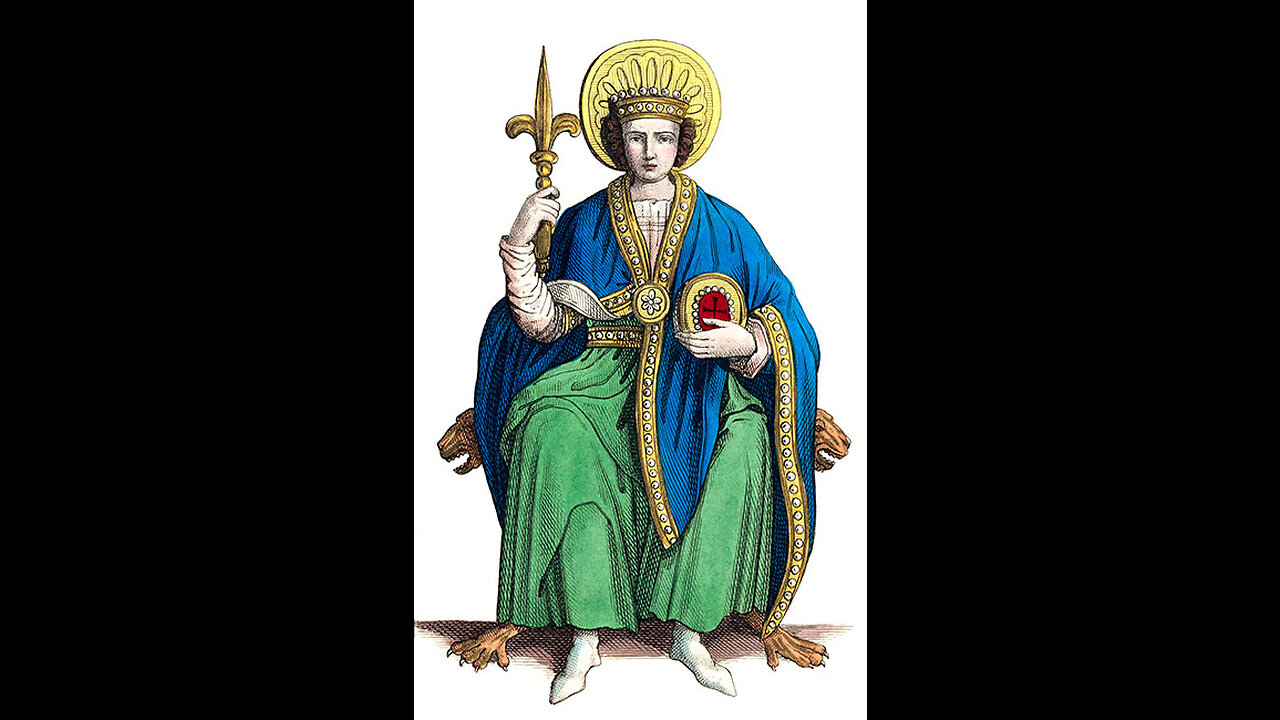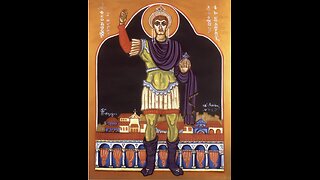Premium Only Content

Titvlvs Patricivs Romanorvm datvs est Pippino a SS. Stephano II P.M. (28 Iul. 754 A.D.)
Titvlvs Patricivs Romanorvm datvs est Pippino a SS. Stephano II P.M. (28 Iul. 754 A.D.)
http://zazzle.com/ProVaticanus
July 28, 754 – Pope Stephen II re-consecrates Pepin III (the Short) as king of the Franks, at the Basilica of Saint-Denis outside Paris, bestowing upon him the additional title of Patricius of the Romans. This marks the first recorded crowning of a civil ruler by a pope. Pepin assumes the role of ordained protector of the Catholic Church.
PATRICIUS ROMANORUM
Patrician of the Romans, an honorary title instituted by Emperor constantine i (306–37) as a personal distinction for his principal juridical and military officers. The emperors of the fifth and sixth centuries conferred it, with other honors such as the consulate, upon barbarian chieftains, as well as upon high imperial officials; individual kings of the Visigoths, Ostrogoths, Franks, and Burgundians all held the title. The patriciate remained honorific. In the West, it survived the imperial collapse of the seventh and eighth centuries only in Italy, where the fact that the effective imperial representative, the exarch of ravenna, was also patricius gave the title genuine political content. After the lombards suppressed the exarchate in the eighth century, the patriciate assumed a new character, which it retained until its extinction. In their search for a ruler to assume the duties of defense that the exarchs had formerly owed to the bishops of Rome, the popes of the late eighth century granted the patriciate to their chosen defenders, the Frankish kings. Pope stephen ii conferred the title upon pepin iii the Short and his sons charlemagne and carloman in 754, when he also anointed and crowned them as kings of the Franks, specifically designating them as protectors of the Roman Church. In 781 Charlemagne likewise saw Pope adrian i anoint and crown his sons Pepin and Louis as kings and proclaim them patricii. The title thus came to be an ancillary distinction of the Frankish kings peculiarly expressive of their political and military obligations in Italy, and after the coronation of Charlemagne as emperor (800), it became an attribute of the imperial office itself. Some scholars have maintained that in bestowing the patriciate, Stephen II and Adrian I deliberately usurped prerogatives of the Byzantine emperors and moved to adapt to papal direction what had been the most powerful imperial office in Italy. The patriciate, however, retained the institutional independence of papal authority that it had held in the time of the exarchate, and, though it was frequently bestowed by medieval popes to secure temporal defenders, it was also assumed in other ways by persons hostile to the papacy. Thus, heads of the great Roman family the crescentii, claimed the patriciate by popular election late in the tenth century, and turned the official powers they attributed to the office toward undermining the alliance between the papacy and the Ottonian rulers at the same time that the emperors themselves used the title "by apostolic benediction." Likewise, Emperor Henry IV, who wore the golden circlet of the patricius at least as early as 1061, commanded Pope Gregory VII to descend from the throne of St. Peter by virtue of the patriciate he held "through the bestowal of God and the sworn assent of the Romans" (1076). Still, because of its close association with papal prerogatives, the insurgent Roman commune abolished the office (1144–45).
Bibliography: l. von heinemann, Der Patriziat der deutschen Könige: ein Beitrag zur Geschichte der Beziehungen zwischen Staat und Kirche im Mittelalter (Wolfenbüttel 1888). f. gregorovius, History of the City of Rome in the Middle Ages, tr. a. hamilton, 8 v. in 13 (London 1894–1902). l. halphen, Charlemagne et l'empire carolingien (Paris 1947). l. brÉhier, Le monde byzantine (Paris 1947–50) v.2, Les institutions de l'empire byzantine. r. folz, L'idée d'empire en occident du Ve au XIVe siècle (Paris 1953); Le couronnement impérial de Charlemagne (Paris 1964). p. e. schramm, Herrschaftszeichen und Staatssymbolik, 3 v. (Schriften der Monumenta Germaniae historica 13; Stuttgart 1954–56). o. treitinger, Die oströmische Kaiser-und Reichsidee nach ihrer Gestaltung im höfischen Zeremoniell (2d ed. Darmstadt 1956). j. deÉr, "Die Vorrechte des Kaisers im Rom (772–800)," Schweizerische Beiträge zur allgemeinen Geschichte 15 (1957) 5–63. w. ullmann, The Growth of Papal Government in the Middle Ages (2d ed. New York 1962).
Ago tibi gratias Deo per instrumenta de L. Stilson pro bono rei publicae, (Creative Commons Acknowledgement): cf. https://www.youtube.com/watch?v=rR7XCS2RtoM
#Pepin #PatriciusRomanorum #NFT
-
 4:27
4:27
ProVaticanus
1 month agoPSS. Imperator Romanus Theodosius Magnus venerandus est in Ecclesia Catholica die XVII Januarii
191 -
 1:22:52
1:22:52
Russell Brand
2 hours agoThey’re Running Out of Road — The Scandals, Experiments & Numbers They Can’t Hide - SF654
69.8K4 -
 1:25:59
1:25:59
The Quartering
3 hours agoCandace Owens Assassination Plot, Fat Acceptance Is Over, James Comey Indictment Thrown Out
101K27 -
 LIVE
LIVE
The HotSeat With Todd Spears
1 hour agoEP 214: Do YOU Believe In Miracles???
645 watching -
 8:22
8:22
ChukesOutdoorAdventures
1 day ago $0.06 earnedMarlin 1894 Trapper in 10mm
3.46K2 -
![[Ep 798] What the Hell is in our Food? | Brotherhood of Terror | 2026 Economic Boom!](https://1a-1791.com/video/fwe2/f7/s8/1/C/a/S/C/CaSCz.0kob-small-Ep-798-What-the-Hell-is-in-.jpg) LIVE
LIVE
The Nunn Report - w/ Dan Nunn
1 hour ago[Ep 798] What the Hell is in our Food? | Brotherhood of Terror | 2026 Economic Boom!
305 watching -
 21:09
21:09
Neil McCoy-Ward
1 hour ago🔥 SHOCK! As This 'UNEXPECTED' Move Has Left Western Leaders Scrambling!
7.09K3 -
 1:17:25
1:17:25
TheSaltyCracker
2 hours agoSALTcast 11-24-25
34.3K56 -
 7:51
7:51
Dr. Nick Zyrowski
6 days agoHow To Starve Fat Cells - Not Yourself!
54.2K6 -
 1:11:53
1:11:53
DeVory Darkins
4 hours agoBREAKING: Hegseth drops NIGHTMARE NEWS For Mark Kelly with potential court martial
113K70